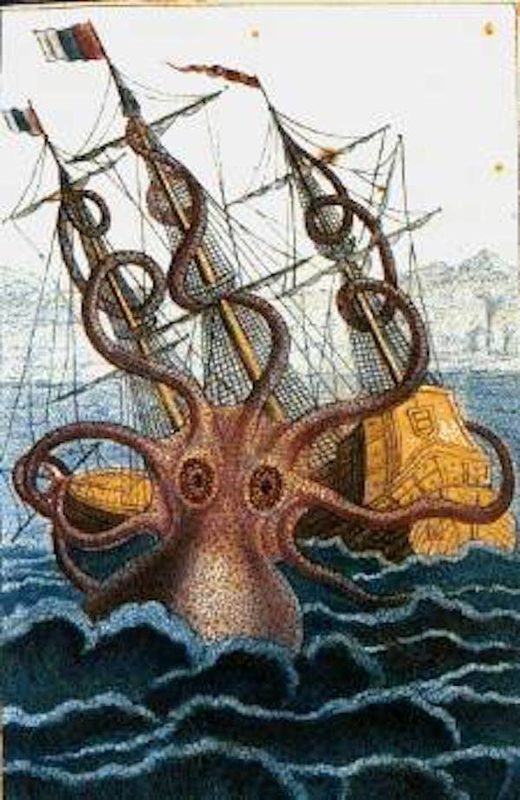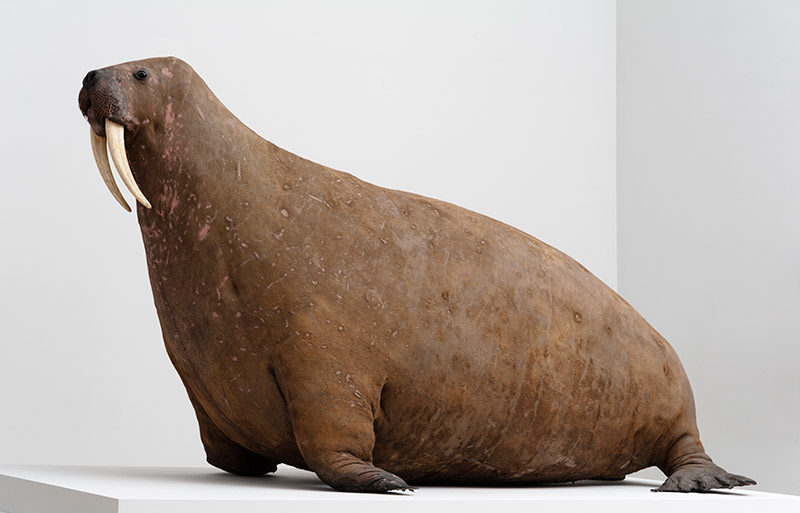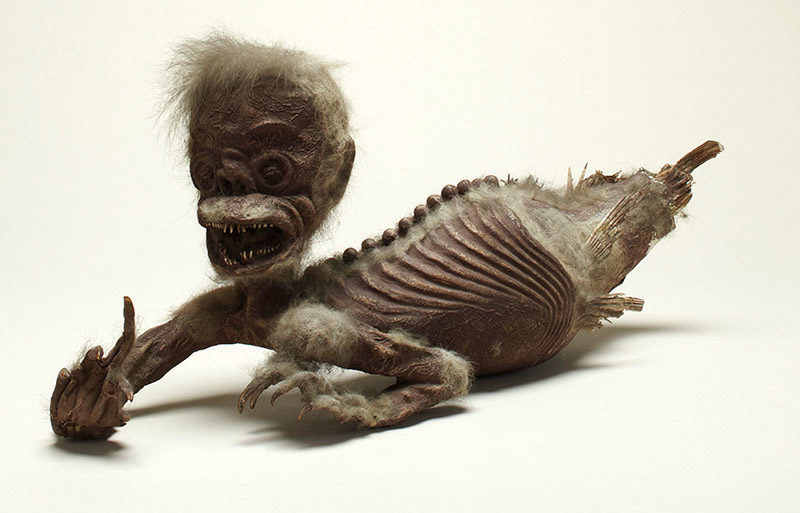
It wasn't long, however, before controversy erupted over these so-called 'chimeras', as they were dubbed by some researchers. Were they human? What would happen if they were allowed to develop? Soon activists mobilized to restrict or quash the research. In 2005, the US outlawed patents on human embryos; in 2007, the Human-Animal Hybrid Prohibition Act was proposed in Congress (although ultimately it failed to pass into law). According to the bill, research into hybrids was said to compromise 'human dignity and the integrity of the human species'. Pig heart transplants or the administration of animal-based insulin were acceptable, but the threat of potentially viable, cellular hybrids was too strong, despite the myriad social benefits it could yield.
These cells were very different in appearance to their mythological namesake, the chimeras of Greek mythology that possessed a lion's head and body, a second goat's head, and a serpent's tail. Yet the rabbit-human embryos and the Ancient Greek image shared a deep similarity in the public imagination: they were both monsters.
The meaning of monstrosity has morphed dramatically over the course of history. Traditionally, monsters came from elsewhere: at the unknown edges of maps, from distant times and places. But as the bounds of the known Universe have expanded, the habitats of monsters shrunk back. The world is now so thoroughly charted that there seems to be little space left for indigenous monsters; instead, we import extraterrestrials and summon up artificial intelligence or cutting-edge technologies to act as the fearsome 'Others' for our books, TV series and films.
But monsters are restless things. Not only have they moved outward; they have also burrowed into our viscera, into our cells, into those ambivalent spaces within the human frame. Since the 19th century, humanity has been consciously developing techniques that can reshape the world in wonderful, dramatic, but often terrifying ways. We have created agricultural systems for taming nature, tools to tinker with the genetic building blocks of life, and machines that might soon be simulacra of ourselves. At the same time, transport and communication networks now connect the globe so completely that pandemics such as Zika and Ebola seem a bigger threat than ever. The modern age has also brought with it the deep isolation of individuals, apparently untethered to place, connecting through screens but divorced from nature. These changes have given rise to a new breed of monsters - ones that originate from the dystopian realities within the human mind.
The word 'monster' derives from the Latin monstrare (to demonstrate) or monere (to warn). Yet defining monsters is difficult. They are a rambunctious lot, less identifiable by what they are than by what they do. According to the American art historian Asa Mittman:
'Monsters do a great deal of cultural work, but they do not do it nicely.' They seem to be terrifying and persecutory things that exist on the very edge of the familiar: unsightly creatures in distant lairs, vampires lurking in the dark. 'They not only challenge and question; they trouble, they worry, they haunt,' Mittman writes. 'They break and tear and rend cultures, all the while constructing them and propping them up.'In the early modern period, monsters were prodigious signs from God: two-headed calves, deformed babies or strange races of humanoids living very far away. Then, from the late-15th century, Europeans began exploring the Far East, northwards to the Arctic and west to the New World, bringing back reports and specimens of extraordinary flora and fauna. Exotic creatures and plants began pouring into Europe. Traditional, aberrant monsters still persisted, but eventually they were superseded by a new kind: organic forms apparently produced by the playful hand of Nature, rather than omens presaging divine wrath.
The novel beasts encountered by European explorers often failed to fit into their traditional ways of organizing the natural world. Aristotle had grouped animals into viviparous quadrupeds (four-legged mammals), oviparous quadrupeds (four-legged egg-layers), birds, whales, and fishes. But many new creatures and plants seemed to be inscrutable hybrids defying taxonomy: the armadillo, for example, arriving from South America, was thought to be a reptile-hedgehog, a Post-Fall miscegenation, resulting from a tryst between a tortoise and a hedgehog cooped up on Noah's Ark.
As the boundaries of the ecumene, or known world, expanded, Europeans became convinced that they had uncovered the monstrous races described by certain classical authors. Explorers such as Antonio Pigafetta, who sailed on Magellan's circumnavigation of the globe between 1519-22, wrote accounts of the alien peoples, habitats and cultures that they encountered, such as the 10-ft giants that Magellan's crew supposedly met in Patagonia.
How far travelers believed what they described, and how much was deliberate fabrication, we don't know. What's certain is that audiences in Europe lapped up these stories, where there was a flourishing market for depictions of the exotic and monstrous. Often, new creatures were not seen alive - or even whole - by people in Europe. They had to be assembled from references in existing texts, token body parts and sailors' reports, who were notoriously prone to exaggeration. Travel was difficult, shipboard conditions were rough, and anything vaguely tasty or easily decomposed tended not to make it back.
The missing parts left imaginative space, which could be filled by scholars and collectors. Natural historians extrapolated from sailors' glimpses of real denizens of the deep to write about terrible sea beasts such as the Kraken, Aspidochelone or Cetus. These creatures were linked to bizarre body parts brought back by merchants - tooth-rimmed sawfish rostrums, whale baleen and colorful tropical shells. Even unicorns were to be found, their physical tokens taking the form of the twisted teeth of narwhals, traded from the Arctic. Real, and even quite mundane, creatures were quite literally made into monstrous simulacra, such as the 'Feejee mermaids' constructed from monkey heads, fish parts and other materials. Similarly, 'Jenny Haniver' dragons and basilisks were eagerly acquired by collectors, shaped from artfully dried rays and skates.
In this way, monsters became the stuff of tangible reality. These objects were exhibited in freak shows for the delight of common audiences, and displayed in cabinets of curiosity to be ogled by a prurient elite. Many writers knew of and recorded the methods used to make these artificial 'dragons' and 'mermaids', and there were fierce debates about their authenticity and provenance. Few doubted there was magic in them, however, or failed to be intrigued by the way they blurred the distinctions between the natural (divine creation) and the artificial (man-made).
This fascination explains how the ferocious Rosmarus came into being. As Europeans began pushing into the Northwest Passage in search of a route to the bountiful Indies, they encountered the walrus - a creature mostly unfamiliar in northern Europe, although Scandinavians had traded walrus products for hundreds of years. These explorers brought back tales of valiant battles against hefty, amphibious beasts with elephant-like tusks, red eyes, impenetrable skin and prodigious strength. Only the valuable tusks, blubber and hides of walruses made it to Europe, along with the hunters' tales of 'russet whales', 'sea elephants' and 'sea horses' that climbed cliffs with their teeth to sleep. These reports, writings and striking objects led to the imagining of the Rosmarus, or hvalross - a hybrid creature as fearsome as its bleak Arctic origins. Such monstrosity was almost certainly used to add cachet to the walrus products sold in European markets.

'Real' monsters such as walruses and whales did not just create markets for new commodities; they also broke boundaries. While this boundary-crossing appears disruptive, in practice these liminal beasts allowed societies to reexamine and rework the categories by which the world was ordered. Flaunting taxonomic rules defined what remained inside the orderly boxes; a whale-horse-elephant walrus or reptile-hedgehog armadillo brought into question what a 'whale' or a mammal or a reptile was, and invited their redefinition. Naturalists made images of these creatures that seemed monstrous, not because they had to, but because monsters were one of the tools being used to develop a new way of looking at the world - one that relied far less on classical textual authority, favoring empirical and novel knowledge.
Take the Australian platypus, a mammal with a duck-like bill, poison spurs and the ability to lay eggs. A specimen was first sent to the Royal Society in London in 1799 by John Hunter, the British governor in Australia. British scientists were astounded by the apparent impossibility of this duck-beaver-fish hybrid, and damaged the body of the creature in their attempts to identify where the different parts had been attached. George Shaw, a Royal Society fellow, wrote that the platypus 'naturally excites the idea of some deceptive preparation by artificial means'. This was a creature so strange, it was thought not to exist, a joke or trick by Nature, a taxonomic monster that stimulated heated scientific debates for decades, and caused the boundaries of what it was to be a mammal to be redrawn.
Monsters and their representations also served to embody moral or political meanings - often by acting as scapegoats. Take the rotund, ungainly dodo that Lewis Carroll described in Alice's Adventures in Wonderland (1865). Yet anatomical evidence suggests that they were probably fairly svelte. The 'obese dodo' appears to be a byproduct of the psychological dynamics of colonial extraction. Dutch sailors first encountered the bird on the island of Mauritius in 1598. Throughout the 17th century, piles of exotic goods, including dodo parts, were brought to Europe by trading enterprises such as the Dutch East India Company. But the embarrassment of riches brought to the Netherlands sat uncomfortably with the country's culture of modesty and restraint.
In this way, the dodo became associated with greed and excess, implicated in the rapacious global trade, and its proportions ballooned accordingly. Based on only travel reports and a few specimens, natural historians depicted the dodo as increasingly engorged. Woodcuts of the corpulent bird were spread far and wide; and no dodos appeared in Europe to challenge such representations. The dodo was said to be 'made for gluttony', and shown as vast and blubbery in paintings such as Roelandt Savery's 'Dodo' (1626), now at the Natural History Museum in London. Scholars described dodos as being able to consume anything, even iron, and to have greasy, sickening meat. By 1681, the bird was extinct - partly thanks to hungry sailors, partly thanks to the land mammals the colonizers had introduced to Mauritius. Its demise presaged that of the Dutch East India Company itself, which would eventually collapse under its own bulk.
Sadly, rendering an animal monstrous has sometimes been used to justify its extermination. By nature, monsters are disruptive and challenging, embodying dark elements that we might want to excise. That was the fate of the thylacine, an Australian marsupial carnivore commonly known as the Tasmanian tiger. It had an eerie mix of canine and feline characteristics, striped fur and an extraordinarily wide jaw gape. But after sheep farming was introduced in Tasmania in the 19th century, the settler population cast thylacines as sheep-killers: they were 'ignoble brutes ... fed on Crown lands' against which war had to be be waged. A bounty scheme was initiated in 1888. Thousands of animals were killed, despite the fact that they had a relatively weak bite and were not particularly rabid murderers of merinos. By the 1930s, the thylacine was largely extinct. The persecution was not the only reason for its demise, but it certainly contributed to it.
One of the striking aspects of the thylacine story is how its depictions have shifted over time. Late-19th-century prints show a rat or hyena-like creature skulking behind sheep pens. These days, viewers are likely to be more familiar with the 1930s photographs of the last few captive animals, or the images by contemporary artists such as Beth Windle, in which the vanished animal appear poignantly majestic. The monster has now become an innocent victim, bringing into question where the monstrosity lies in our own time.
What gives us the right to make animals into monstrous vermin? In the early modern period, the world was ordered in a hierarchical structure, with an unmistakeable distinction between humans and other creatures. However, a growing understanding of the history of life during the 18th and 19th centuries - especially after Charles Darwin's account of the theory of natural selection in On the Origin of Species (1859) - brought the nature of humanity and our place in nature into question. If we were all related, from one common ancestral lineage, were humans really so distinct from other species?
Growing uncertainty about the boundaries between humans and other animals gave rise to new kinds of monsters. The bestial yet humanoid 'wild man', for example, was used in early descriptions of the orangutan, such as those by the physician Jacobus Bontius in Historia Naturalis & Medicas Indiæ Orientalis (1658). Bontius speculated that this animal was the offspring of native women and apes, a crystallization of 19th-century fears of colonial miscegenation. Even as late as 1844, the doctor Thomas Blatchford wrote in The Boston Medical and Surgical Journal that the only animal that might ever be 'able to impregnate the female of our own species besides her own appropriate lord' was 'the ourang-outang of Borneo'.
The dissolving borders between humans and other species coincided with internal migration of the monstrous: from the realm outside the human, to a place within it. Throughout the 19th and 20th centuries, literature suggested monstrosity was a product of our own actions and psyches. Victor Frankenstein created his own monster in Mary Shelley's 1818 novel, while in Bram Stoker's Dracula (1897), the victims invited the vampire into their homes. In his essay 'The Uncanny' (1919), Sigmund Freud described the feelings evoked by such humanoids as being both novel and eerily familiar, arousing a 'dread and creeping horror'. Freud, who was Jewish, was ultimately forced to flee his native Vienna to escape the mass extermination of the Holocaust - enduring evidence, for many, of the most monstrous features of human nature.
Today, such uncanny humanoids have developed into the AI robots capable of passing as humans, or more than humans. In the film Ex Machina (2014), robots are amoral brutes that serve to demonstrate where real monstrosity lies: in their psychopathic creators. Even with the technological tools at hand today, commentators in the industrialized West worry that people's psyches have become pathologically damaged, detached and alienated from one another, rendered monstrous by the forces of late capitalism. In modern horror movies, the monster is as likely to be an ambivalent psychological force, or to reside internally, as it is to be an external threat.
There is now mounting evidence that the material residues of human enterprise can infiltrate and damage our bodies: refined sugar, endocrine-disrupting plastics, nuclear waste, intensively farmed meat. Such monstrous markers of the Anthropocene can no longer be disowned or banished. We are now able to 'play God' using gene-editing tools such as CRISPR, to bring back extinct species, or to create entirely new ones. Films such as Jurassic Park play on the fears of what might happen were we to lose control of our revenants: we might become prey to our own creations, ceding power to natural forces that have just as much right to the Earth as we do. Similarly, fears of bioterrorism and deadly synthetic organisms have taken on new bite.
In other words, monstrosity has moved onto our very doorstep. Societies throughout history have feared beasts living in the woods, at the edges of the known world, in the depths of the oceans. Now that we have mapped the world's inhospitable places, the only places for monsters to dwell are the uncharted spaces within. We have become the monsters from which the world must be protected.
Just what can facing our modern demons show us? We have created and remade monsters in a multitude of guises over time. They are elements of our imaginations that need to be expressed - the violent byproducts of our fears, not the reason for them. Monsters are challenges to the order that we strive to impose on the world, and help us to negotiate our place in it. By facing and understanding these anthropogenic terrors, perhaps we can begin to tame them - and so start to shape a new, more benign place in the world for ourselves and other species.
About the author
Natalie Lawrence is a nature writer and historian of science, whose work has appeared in The Observer and BBC Wildlife magazine, among others. She is the author of Feathers and Eggshells (2005) and lives in London.




Reader Comments